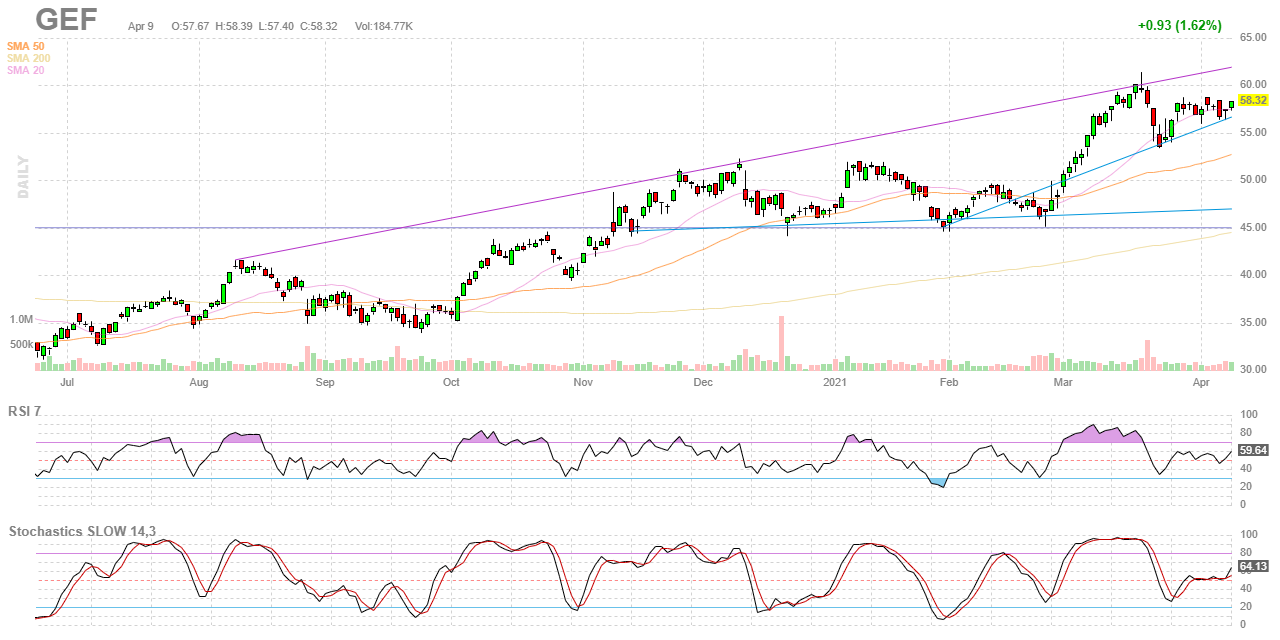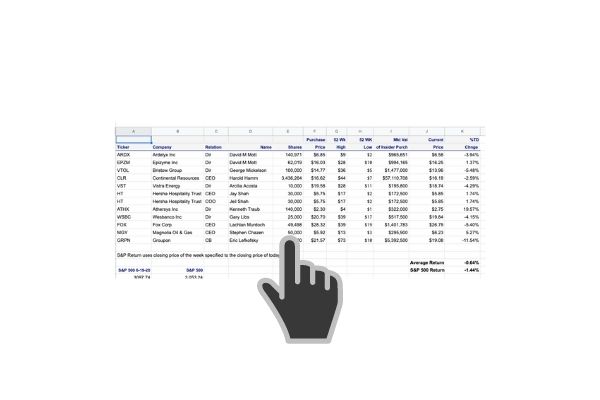For trade details click on this link to the trades
| % Trade Date | ||
| Company | Ticker | Change |
| insider-trading/1801777.htm”>Applied Molecular Transport Inc. | AMTI | 16.50% |
| DELCATH SYSTEMS Inc | DCTH | 7.07% |
| JOANN Inc. | JOAN | 4.49% |
| REPUBLIC SERVICES Inc | RSG | 4.13% |
| Howard Hughes Corp | HHC | 2.85% |
| Science Applications International Corp | SAIC | 1.04% |
| TCW STRATEGIC INCOME FUND INC | TSI | 0.07% |
| TCW STRATEGIC INCOME FUND INC | TSI | 0.05% |
| GREIF INC | GEF | -1.45% |
There was very little insider buying of note this last week. If you rule out the almost daily offerings of new SPACS which are for the most part future mediocre to poor investments by self-dealing promoters of various ilks, there was very little in the way of insider activity. Is this the calm before the storm; the blackout period before 1st quarter earnings, when most insiders are prohibited from trading in their company’s stock? We won’t know the answer to that for a few weeks now.
The trade of the week was Applied Molecular Transport Director David Lamont’s purchase of 25,000 shares of AMTI at $42 for a 16.50% weekly gain. Applied Molecular Transport Inc. is a clinical-stage biopharmaceutical company leveraging its proprietary technology platform to design and develop a pipeline of novel oral biologic product candidates to treat autoimmune, inflammatory, metabolic, and other diseases.
AMTI just did a secondary at $42 per share and it looks like he bought it on the secondary, even though the trade dates don’t line up. There was no way AMTI was trading at $42 per share on April 6th the reported trade date so we are left to conclude that he could only have purchased those shares at the secondary. A more sinister conclusion is that seeing how well the stock traded afterward, that the underwriter sold Lamont some of its “greenshoe” shares at the discounted price. In fact, that’s the only conclusion that lines up with trade dates and stock prices. A nice little treat for sending them the business, I guess
CFO Natarjan purchased 3000 shares of Science Applications SAIC at $84.31. Science Applications International Corporation is an American company headquartered in Reston, Virginia that provides government services and information technology support. Wikipedia
SAIC was the subject of numerous downgrades on its disappointing guidance on reporting 4th quarter earnings on March 25th. It seems that this purchase by the CFO was a typical kitchen sink announcement where the company blames on results on its past and lowers the bar going forward. Science Applications International Corp. (NYSE: SAIC) today announced the appointment of Prabu Natarajan as executive vice president and chief financial officer, effective January 4, 2021. Natarajan will report to CEO Nazzic Keene and will succeed Charlie Mathis, who announced his retirement earlier this year.
Natarajan joins SAIC from Northrop Grumman Corp., where he has served in a variety of financial, tax, and management roles since 2011. Most recently, he has served as Northrop Grumman’s vice president for financial strategy and planning, vice president for mergers and acquisitions, and acting vice president of tax. Before that, he served as the chief financial officer for the company’s Information Systems business and as corporate vice president and treasurer.
This is a two-pronged probability outcome:
- Did Natajaran buy the stock because he is expected to own stock as the new CFO and with the 15% drop in price, this was an opportunity he was waiting for?
- Did he buy the stock because this was a kitchen sink quarter, where the management bit the bullet and threw out all the bad news and is going to beat expectations going forward?
If we see more insiders buying here we would jump in but until then, it is likely the first outcome. He is expected to own shares.
We don’t normally blog about IPOs because the average investor can’t purchase them at the IPO price as its a game promoted by underwriters to reward the Company’s friends and families, and the banks’ best customers. But when a stock dips precipitously below the IPO price and the CEO buys a significant amount, it warrants a closer look. That’s the case with JOANN Inc. CEO Miqueln purchased 47,550 shares of JOAN at $11.36.
Jo-Ann Stores, Inc. is an American specialty retailer of crafts and fabrics based in Hudson, Ohio. It operates the retail chains JOANN Fabrics and Crafts and Jo-Ann Etc. The headquarters of the company is located in the former General Motors Terex plant. Wikipedia.
According to The Fly on the Wall, JOAN reported Q4 revenue $840.8M vs. $695.6M last year. Total comparable sales increased by 21.2%. Omni-channel net sales grew by 194% in the fourth quarter as compared to the same period in the prior year and represented 16% of total sales. From a single storefront in Cleveland, Ohio, the nation’s category leader in sewing and one of the fastest-growing players in the arts and crafts category has grown to include 855 stores across 49 states and an industry-leading e-commerce business.
JOAN did an LBO with Lenoard Green Partners in 2010 for about $1.6 billion AND now it’s back with an IPO at $12 below its initial price talk of $15-17. The underwrites would like you to believe that sewing is booming under the new demographics-
One thing noted in the Joann IPO prospectus is a change in demographics. As a result of millennials taking up the hobby, the number of sewers has grown at a compound annual growth rate of 12% since 2012. SVP Worldwide estimates that 65% of sewers are 30 years old or younger. This brought the average age of a sewer down from 48 in 2004 to 37 in 2020.
So, in summary, Joann is a market leader in sewing and a large player in arts and crafts and is well-positioned to continue growing its business. Will it be a better investment for the public at less than half the market cap Leonard Green Partners paid? Probably so. Are we buying? Not yet.
Director Model purchased 4300 shares of Howard Hughes Corp HHC at $97.17. Howard Hughes Corp is a real estate development company most closely associated with hedge fund magnate Bill Ackman. The Howard Hughes Corporation is a major real estate development and management company based in The Woodlands, Texas. It began as part of the oil drilling tool business founded by Howard R. Hughes, Sr., in 1913, which under his son Howard Hughes, Jr., diversified into real estate development. Wikipedia
We are extremely leery of investing in any REITs with office space exposure, no matter the pedigree of their investors. Ironically the shares that Director Model are buying now were sold by him on 12/29/20 at $80.11
CEO Michel purchased 15,500 shares of Delcath Systems DCTH at $12.88. Delcath Systems, Inc. Delcath Systems, Inc. is a publicly-traded specialty pharmaceutical and medical device company that develops percutaneous perfusion technologies for the targeted administration of high-dose chemotherapeutic agents to specific organs or regions of the body. Wikipedia
Delcath’s state goal is Upon approval, to be the treatment of choice for patients with ocular melanoma liver metastases. Ocular melanoma, also referred to as uveal melanoma, is a cancer that originates in the eye. Approximately 4,500 patients in the United States and Europe are diagnosed with ocular melanoma each year. About half of patients diagnosed with ocular melanoma develop metastatic disease (cancer spreads beyond the primary source). Of those, the liver is the first site of metastases 80-90% of the time. Delcath aims to change the lives of patients suffering with ocular melanoma liver metastases through our clinical program. It’s clearly a vote of confidence to see the CEO purchasing shares with two Phase III trials underway.
It’s interesting to us that portfolio manager Landmann purchased 100,191 shares at TCW Strategic Income Fund Inc TSI at $5.67. The Funds investment objective is to seek a total return comprised of current income and capital appreciation by investing in convertible securities, marketable equity securities, investment-grade debt securities, high-yield debt securities, options, securities issued or guaranteed by the United States Government, its agencies, and instrumentalities, repurchase agreements, mortgage-related securities, asset-backed securities, money market securities, and other securities. It has a distribution rate of 3.86% and is trading at a slight discount to NAV

VP Martz purchased 7000 shares of GREIF Inc GEF at $59.18. This is a thoroughly confusing purchase he sold 24,000 shares on the same filing at $58. There have been other simultaneous sales and purchases by Grief insiders Grief is a global leader in industrial packaging products and services and is pursuing its vision: In industrial packaging, be the best performing customer service company in the world. Wikipedia
GEF looks like a good idea. They just raised recycled paperboard prices. If you’re looking for a way to play coated paperboard, global industrial packings, and paper packaging, Grief might just be the way.

When one of the world’s most influential persons’ investment arm buys any stock, you have to take notice. All the more so when he just published his diatribe about global warming, How to Avoid a Climate Disaster. When this company is one of the world’s largest waste management companies, we have to wonder what’s up. Cascade Investment, the Gates investment vehicle, purchased 10,055 shares of Republic Services RSG at $99.44. Gates already is the largest owner of RSG with 108,812, 576 shares, or about 33% of the company. Gates also is a major holder of Ecolab, Inc ECL, and Waste Management. It’s hard to say if this is a significant development or not. After all, Gates is the 2nd richest person in the world and has vast holdings in many companies. His largest outside investment is in Berkshire Hathaway, which constitutes about 43% of the investment portfolio.
Republic Services, Inc is the second largest provider of non-hazardous solid waste collection, transfer, disposal, recycling, and energy services in the United States, as measured by revenue
Follow us on Twitter for real time insider buying alerts at https://twitter.com/theinsidersfund
[custom-twitter-feeds]
Insiders sell stock for many reasons, but they generally buy for just one – to make money. You’ve always heard the best information is inside information. Everyone who has any experience at all in the stock market pays close attention to what insiders are doing. After all, who knows a business better than the people running it? Officers, directors, and 10% owners are required to inform the public through a Form 4 Filing any transaction, buy, sell, exercise, or any other with 48 hours of doing so. This info is available for free from the SEC’s Web site, Edgar, although we subscribe to SECForm4 as they provide a way to manage and make sense of the vast realms of data. I’ve tried a lot of vendors and SECForm4 is one of the most customer-friendly and responsive I’ve used.
We publish a subscription newsletter called The Insiders Report. We offer a free 30-day trial so you have nothing to lose by trying it out. Be sure to carefully read the TERMS OF SERVICE.
Another source for insider buying and selling and much more is FinViz Elite. FinViz stands for financial visualization and they do an amazing job of providing reams of data and the tools to help you get to the bottom of it, the information that helps me make informed decisions and probable outcomes. I’ve been using their site for years and it only gets better over time.
This is as close to “insider information” that an ordinary investor is likely to see- and it’s entirely legal.
BEWARE– Following insiders can be hazardous to your financial health unless you know what you are doing. Unlike the raw, unfiltered data, The Insiders Fund blog informs you of the purchases that count, the ones that are just window dressing into deceiving the public that all is hunky-dory, and those that are just flat out other people’s money and should be just discarded like bad fish. As a rule, we only look at material amounts of money, $200 thousand or more, as anything less could just be window dressing.
The bar is different from selling because the natural state of management is to be sellers. This is because most companies provide significant amounts of management compensation packages as stock and options. Therefore, with selling, we analyze for unusual patterns, such as insiders selling 25 percent or more of their holdings or multiple insiders selling near 52-week lows. Another red flag is large planned sale programs that start without warning. Unfortunately, the public information disclosure requirements about these programs referred to as Rule 10b5-1 is horrendously poor. Also planned sales that just pop up out of nowhere are basically sales and are seeking cover under the Sarbanes Oxley corporate welfare clause. I also generally ignore 10 percent shareholders as they tend to be OPM (other people’s money) and perhaps not the smart money we are trying to read the tea leaves on.
Of course, insiders can also be wrong about their Company’s prospects. Don’t let anyone fool you into believing they never make mistakes. No one tracks and understands insider behavior better than us. We’ve been doing it religiously since 2001 when I quit being an insider myself and devoted myself full time to managing my personal investments. They can easily be wrong about how much others will value them, and in many cases, maybe most cases have no more idea what the future may hold than you or I. In short, you can lose money following them. We have and we curse aloud, what were they thinking! Needless to say, past good fortune is no guarantee of future success. We may own positions, long or short, in any of these names and are under no obligation to disclose that. We welcome your comments on our analysis.
This blog is solely for educational purposes and the author’s own amusement. I basically use it as my own worksheet. If we make money off this endeavor, no one will be more surprised than me. My sincere hope is that self-directed investors can learn from my realms of experience. Investing with The Insiders Fund is for qualified investors and by Prospectus only. Nothing herein should be construed otherwise. THE INSIDERS FUND invests in companies at or near prices that management has been willing to invest significant amounts of their own money in. If you would like to hear more about how you can get involved with the Insiders Fund, please schedule some time on my calendar.
Prosperous Trading,
Harvey Sax
The Insiders Fund was the 4th best long-short equity fund in the world in 2019, 4th Best in November 2020, 4th Best in January 2021 (I kid you not, 2 is actually my lucky number. I’m hoping for that in February when were up 15%)


